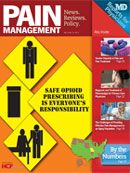Publication
Article
Pain Management
Safe Storage and Disposal of Opioids and Other Medications
With concern over the misuse, abuse, and diversion of opioids and other prescription medications for pain at an all-time high, it is imperative that physicians review safe medication handling, storage, and disposal procedures with patients
With the majority of people using prescription opioids for non-medical reasons obtaining them from friends or family members (http://hcp.lv/pv7VMe), often without their consent, it is vitally important that patients safely store and dispose of their medications. There are several good resources available online from the professional pain management societies and patient advocacy organizations. A fairly typical example is Opioid Medications and REMS: A Patient’s Guide, (http://hcp.lv/ qLLUhS), which was created for the Ready for REMS initiative. It includes several brief tips on safe prescription opioid storage and disposal, reminding patients to keep their opioid medication “stored in a safe, secure, dry place, where a pet, child, teenager, or stranger cannot get to it.” The guide also recommends against storing opioids in several different locations around the home. Patients are also cautioned to “keep the tablets in a bottle with a child-resistant lid, and keep the bottle in a secure lockbox” that is approved by their doctor.” Only the patients and his or her caregiver should have access to the lockbox.
The Guide also includes advice on how to properly dispose of unused or expired opioids, reminding patients that “expired and unused opioid medication should never be saved.” Patients who receive prescriptions for a different dose of their current medications or who receive prescriptions for new medications must safely dispose of their leftover medication. The Guide instructs patients to consult the medication guide that accompanied their prescriptions for tips on safe disposal, or to follow the instructions given to them by their physician or pharmacist. As far as actual physical disposal of their unused meds, some opioid medications “can be flushed down the toilet; other kinds should be broken up and mixed with coffee grounds, cat litter, etc” prior to being thrown away (this makes the medication “less tempting to children or pets and unrecognizable to people who may intentionally search through your trash”). Before flushing their meds (for those that can safely be disposed of in this manner), patients should contact their local water treatment or sanitation department to see if their community has restrictions regarding flushing medicines down the toilet and to find out how to safely dispose of medicines in their community. Before discarding empty pill bottles, patients should also remove all labeling to protect their identity.
Still not sure what to do with those meds? The DailyMed website (http://hcp.lv/p5V6KD), developed by the US National Library of Medicine, provides “a standard, comprehensive, up-to-date, look-up and download resource of medication content and labeling as found in medication package inserts.” Visitors can search by drug name or class and then look for storage and disposal instructions in the medication guide, patient package insert, and other information supplied for that drug.
The FDA offers several good resources that offer detailed information and instructions about how to properly dispose of prescription pain medications, including “Disposal of Unused Medicines: What You Should Know,” which features a list of medications recommended for disposal by flushing (last updated in 2010). The list includes Demerol tablets and oral solution, Embeda extended release capsules, Exalgo extended release tablets, Fentora tablets, methadone hydrochloride, MS Contin, oxycontin, Onsolis, Opana, Percocet, and others (http://hcp.lv/r28nBl). The FDA addresses concerns over what it refers to as “recent reports that have noted trace amounts of medicines in the water system” by noting that “The majority of medicines found in the water system are a result of the body’s natural routes of drug elimination (in urine or feces). Scientists, to date, have found no evidence of harmful effects to human health from medicines in the environment. Disposal of these select, few medicines by flushing contributes only a small fraction of the total amount of medicine found in the water. When a medicine take-back program isn’t available, FDA believes that any potential risk to people and the environment from flushing this small, select list of medicines is outweighed by the real possibility of lifethreatening risks from accidental ingestion of these medicines.”
The Drug Take-back Network (http://hcp. lv/owMqAh) website offers information about “strategies already underway to reduce drug abuse and accidental poisonings, and to improve water quality by offering consumers a safe option for disposing of their unused drugs.” Visitors to the site will find links to information about permanent and/or regularly recurring programs to collect and dispose of unused medications in 22 states. The site also includes a link to a national directory (searchable by ZIP code) of “one-time, occasional, or on-going takeback programs.”
